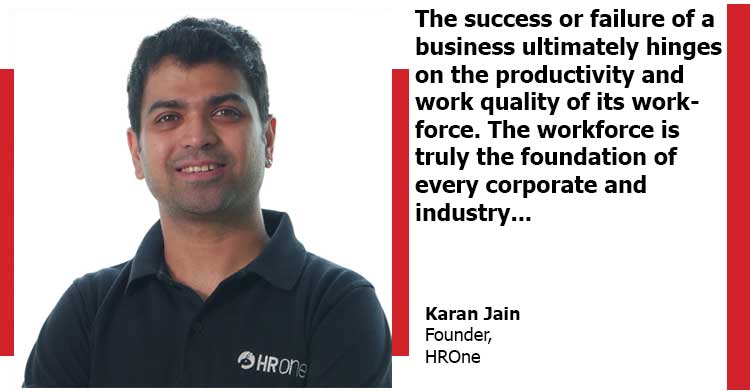Employee Experience management is the key to business success: 11 Tips to Excel | Karan Jain | Founder | HROne

The success or failure of a business ultimately hinges on the productivity and work quality of its workforce. The workforce is truly the foundation of every corporate and industry, and understanding their experiences within an organization is crucial. This is where employee experience comes into play, as it enables organizations to gain valuable insights into the needs and sentiments of their people.
The unprecedented changes the world of work has gone through have severely impacted and shaped how employees act and what they expect. The workforce is fluid and diverse making each of them have a different ‘want’
driving a great ‘EX’ for them.
There does exist a common underlying tone to their expectations making work-life balance, employee engagement, and productivity vital elements for HR to decide what kind of experience their employees are gaining. If it becomes complex and opaque, employee experience management (EXM) could become the key to improving the overall situation.
Build Better Understanding for the Employees
The pillar of EXM is based on how much HRs or CXOs understand their people or teams. Being an HR or CHRO, developing empathy and putting people first should be a priority if your employees are not happy or motivated at their jobs. Build a workspace where your employees feel much appreciated, assured, listened to, and valued.
Bring Dynamic Leaders
Dynamic leaders know the way, go the way, and show the way to their people – a famous quote by the author, John C Maxwell.
Without good leaders, it is more challenging for an organisation to establish a great company culture and a more positive working atmosphere. They offer their team the required direction and vision to achieve certain goals.
Create more Learning Opportunities
A workplace should be a place for learning and development for the employees. Offer your employees more learning, skilling, and reskilling opportunities. These opportunities give more confidence to your employees to take on new challenges, improve their skill set, and get career maturity within an organisation.
Continuous Feedback and Evaluation
Employee experience management is an ongoing process and not a once-in-a-blue-moon practice. The HR department should continuously identify the issues and improve them regularly to ensure employee satisfaction and a
transparent workplace setting.
Offer Smooth Onboarding
Onboarding is a vital period for both; new employees and HR. Offer an optimised and smooth onboarding to new hires by providing information regarding their job and tasks, the right tools and software, and a lot of training and guidance to avoid frustration.
Accept Inclusion and Diversity
If an organisation has a diverse workforce, its culture, policies and hiring practices must support diversity and inclusion. Ignoring these critical components could lead to stereotyping, disrespect among employees, and stress.
Give Priority to Work-Life Balance
Employees have realised the essentiality of work-life balance. An organisation must necessitate changes in their office programs and policy to offer flexible workspace, remote work options, more breaking hours, and prioritise employees’ mental and physical health.
Notice the Departuring Employees
Employees leave organisations regardless of what kind of employee experience they get. It is necessary to know what motivates them to quit. An organisation must benefit from the employees’ feedback and take time in introspecting and improving.
Recognize and Reward Performers
Reward and recognition are salient components of employee experience. It isa good way to motivate other employees by gratifying the performers with gifts or rewards. It imbues gratitude and inspiration.
Get Rid of Micromanagement
The less micromanagement, the more employee experience. Employees don’t feel very comfortable with constant nagging from seniors or management. Micromanagement spreads a feeling of insecurity among the workforce. Empowering employees to take ownership and responsibility for their jobs improves the EXM.
Focus on Employee Retention
Better employee experience or ‘EX’ retains employees. An organisation should keep high-performers and talented workers for success and avoid frequent turnovers. To make employees stay, compensate them fairly, focus on employee engagement, and accommodate them.
Summing Up!
Overall, EXM is a key element in making any business a success. Organisations can start investing in their employees, listening to their feedback, bridging the gap between leaders and team members, and prioritising work-life balance. By taking these approaches, an organisation can easily retain and attract employees and drive growth in the competitive market.


